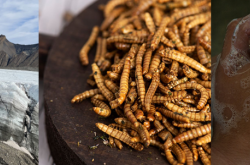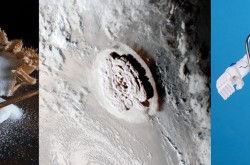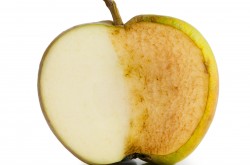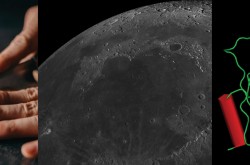3 things you should know about PEI potato wart, Saturn’s moon Mimas, and animals with built in antifreeze.

Meet Renée-Claude Goulet, Cassandra Marion, and Michelle Campbell Mekarski.
They are Ingenium’s science advisors, providing expert scientific advice on key subjects relating to the Canada Agriculture and Food Museum, the Canada Aviation and Space Museum, and the Canada Science and Technology Museum.
In this colourful monthly blog series, Ingenium’s science advisors offer up quirky nuggets related to their areas of expertise. For the March edition, they explain how a soil fungus forced PEI Potatoes into quarantine, that a hidden ocean may cause Saturn’s moon Mimas to wobble, and how some animals have built in antifreeze.

Potatoes are vulnerable to several fungal diseases. Potato wart, Synchytrium endobioticum, is considered across the world as a “quarantine pest” – it is under strict regulation to prevent its spread.
A soil fungus forces PEI potatoes into quarantine
It’s no secret that Prince Edward Island is a great place to grow potatoes. In fact, in 2021, PEI spud farmers were responsible for a whopping 23.2% of Canada’s total potato harvest for the year.
However, come November 2021, farmers who grew seed potatoes for export to the United States were hit with some devastating news: until further notice, PEI seed potatoes were blocked from entering the US. The detection of a dreaded fungal disease – potato wart – in two fields in the island province had set off very strict plant quarantine measures meant to prevent the spread of the disease across national and provincial borders.
Though it poses no risk to human health, this particularly nasty fungus infects young potatoes and creates large unsightly growths, or warts, on their exterior. This decreases yield and makes the potatoes unmarketable, thus having serious economic and food security consequences if left unchecked.
The fungus travels on contaminated machinery, in infected soil and potatoes, and even in manure from animals which ate diseased potatoes. There are no chemical or biological options to get rid of this fungus once it’s in the field, and it can go dormant and re-emerge in the same field decades later. The most efficient way to manage it is to make sure it doesn't get in fields in the first place.
Potato wart was first detected in PEI in 2000, and borders were shut then, too. Since then, the Canadian Food Inspection Agency (CFIA) has kept very close tabs on the disease. To prevent its spread, potato wart is managed in Canada under the Plant Protection Act, and all over the world through the International Plant Protection Convention of the United Nations’ Food and Agriculture Organization.
Luckily, in December, through investigation and extensive soil testing, the CFIA has confirmed that Canadian farms are free of the fungus, and that our potato exports are safe. But it is too late for some farmers who have had to destroy their harvest due to their quarantined potatoes’ quality degrading to the point of making them unsellable.
Being able to quickly detect and contain any possible plant disease outbreaks contributes to preventing huge agricultural losses in the long term. However, the PEI example also highlights how approaches to blocking the spread of plant diseases need to include strategies to reduce harms to farmers and food security as the crisis is being managed. Compensation to farmers, establishing the appropriate streams to quickly process any salvageable products, novel alternative uses for compromised harvests, as well as development of local food systems can help quell the impacts of future plant pandemic prevention efforts.
This is not the first time Canada has had to respond to the threat of a plant pandemic, and it certainly is not the last. Climate change is expanding the types and ranges of harmful pests attacking crops and animals. Strong measures and co-operation around the world, as well as early detection, monitoring, and predictive tools will all contribute to keeping these threats to agriculture under control.
By Renée-Claude Goulet

A mosaic image of Saturn’s heavily cratered moon, Mimas, and its large Herschel crater captured by the Cassini spacecraft.
Hidden ocean may cause Saturn’s moon Mimas to wobble
A recent study suggests Mimas, one of Saturn’s moons, may have a present-day liquid ocean hiding beneath its icy crust.
Earth is the only body in the solar system with the right conditions to support a liquid water ocean on its surface. In the cold outer solar system, there is mounting evidence to suggest there are several frozen ocean worlds that may be warm enough to have a liquid ocean hiding below an icy crust. To date, these include several gas giant moons: Enceladus, Europa, Ganymede, Callisto, Titan, and Triton; and the dwarf planet Pluto.
The nearly 400 km-wide Mimas is known affectionally as the Death Star moon for its strikingly large 130 km-wide impact crater named after the moon’s discoverer, William Herschel. It is the smallest and innermost orbiting of Saturn’s large moons. Mimas’ rough surface is laden with impact craters and, until recently, it was thought to be a pretty inactive, slightly football-shaped ball of rock and ice.
The Wobble and the Heat
NASA’s Cassini mission, known for exploring Saturn and its moons, detected and measured Mimas’ physical libration – how it wobbles as it rotates – and its orbit. The Cassini mission team found it had an irregular wobble, which suggested it may be geologically active. This drove scientists to evaluate and model what internal structure or conditions may cause the wobble.
Tidal forces, that is the powerful gravitational pull exerted by Saturn, cause the much smaller Mimas to stretch and relax as it rotates. This squeeze-and-stretch generates internal friction and heating. The study’s models show that Mimas should have just enough heat to keep both a hidden ocean from freezing and a 25 km-thick ice crust on the surface from thawing.
The next challenging question is how Mimas could have developed an ocean without leaving any geological evidence on its surface? Other ocean worlds commonly have smooth surface features, stress fractures caused by tidal stresses, or evidence of geological activity in the form of the geysers, like those observed erupting on Enceladus. All of which are lacking on Mimas.
Further investigations and modeling of Mimas are needed to support the ocean hypothesis. That said, if this heavily cratered little moon does have a ‘stealth’ ocean, and sci-fi joking aside, it would have far-reaching implications for all future studies of icy worlds, as well as the other bodies within the Saturn system. It may also evolve how we characterize a potentially habitable world.
Go Further
The case for an ocean-bearing Mimas from tidal heating analysis, the abovementioned article in Icarus.
Jupiter’s largest moon, Ganymede: The view from Juno
By Cassandra Marion

These critters may be tiny (less than a millimetre), but they have a major superpower: antifreeze!
Cold but not freezing: How some animals have built in antifreeze
At the end of a long winter, what reminds you that spring is coming? Is it the first plants pushing up through melting snow? The return of geese from the South? The groundhogs waking from hibernation? Or perhaps (as I noticed during last weekend’s walk) the arrival of snowfleas?
Snowfleas – which are more properly known as springtails – are not fleas, nor even insects (though they are close cousins). They’re actually called collembolans, and are found in soil all around the world where they eat dead vegetation. They’re active year-round, but in Canada, they’re most obvious in late winter when they climb up through the snow towards the sun. This is where their nickname comes from.
Surviving winters without freezing is tricky for most living things. Most organisms can survive getting a bit chilly, but at some point, their cells will start to freeze. As ice forms within cells, the movement of water and the sharp edges of ice crystals can actually rip apart and kill delicate cells and tissues (this is called frostbite).
To survive, organisms use a variety of strategies. Geese migrate to warmer climates, groundhogs hibernate, deciduous trees lose their leaves and go dormant, and some organisms – like the snowfleas – use antifreeze.
Antifreeze proteins grab onto ice as it starts to form within the body and stop those small bits of ice from growing into larger ice crystals that could cause damage.
Antifreeze proteins were first discovered in Antarctic fishes, and since then they have been identified in plants, bacteria, insects, arachnids, fungi, and yeast. By resisting freezing, these organisms can live in, on, and around ice and snow. In more extreme cases, some organisms (including certain frogs!) use similar proteins to control ice crystal formation in ways that allow them to freeze solid without damaging their cells and tissues. Then, when temperatures warm, they thaw, wake up, and continue on with their lives.
Antifreeze proteins get a lot of research attention because of their great potential. Researchers are investigating how antifreeze proteins could be used to lengthen the shelf life of frozen foods, increase frost resistance in plants, treat frostbite, improve tissue preservation during organ transplant, and better preserve eggs, sperm, and embryos. One day, antifreeze proteins may even allow humans to be frozen for space travel.
So as you walk the trails this winter, look for tiny moving specks near the base of trees. These little winter critters are taking advantage of one amazing cold-weather adaptation.
By Michelle Campbell Mekarski
Enjoying the Ingenium Channel? Help us improve your experience with a short survey!









































